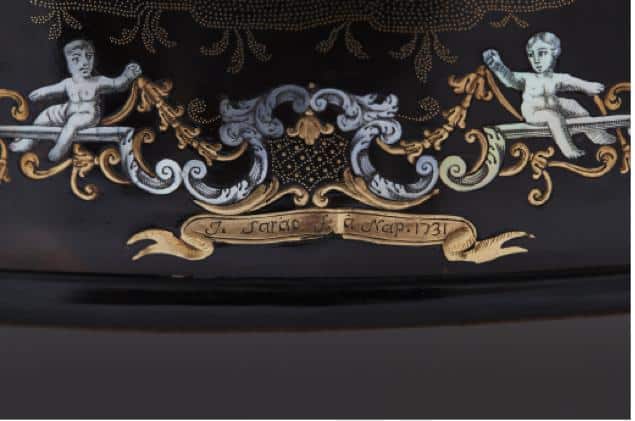Turtle: the use in ancient art and the Piqué technique in Naples
The modern ethical conscience and the attention that in the last century (especially in the last decades) has been paid to the protection of the environment and the ecosystem have finally put turtles, as well as elephants and many others under protection and protection. animals.
These creatures, still victims of illegal poaching today, have been over the past centuries the object of hunting for the recovery of materials considered precious: the carapace of the turtle, the ivory of the elephants, the tooth of the Narwhal, the precious skins of the felines or crocodiles, but also corals and exotic plants now in danger of extinction such as rosewood.
We have cited only a few of the best known examples that have forced governments to take measures that prohibit their processing and trade. Many countries have decided to even ban the sale and trade of ancient objects, believing that the commercial success of their sale could stimulate the production of copies, thus helping to encourage hunting for certain animal species.
Thus we come today to excesses of zeal where ancient works of art are burned in pyres because they contain these materials. Perhaps excessive measures? We do not want to enter here into complex ethical assessments which on the one hand see the risk of hitting a heritage, but which have undoubtedly produced results, such as that of having brought down the ivory market, hitting poaching hard. The fact remains that in most countries objects of proven authenticity and age can be exhibited, bought and sold as works of art; in fact, museums around the world boast examples of this in their collections.
We want to discuss, in some in-depth sheets, what was the use of some of these materials, to explain the fascination they aroused among collectors of ancient times. In fact, they very often entered the Wunderkammer as rare and precious elements, wonders.
Among these there is undoubtedly the turtle, a natural material, widely used as a decorative element in the production of art objects and luxury furnishings.
The turtle in fact, since the most ancient times, has been recognized as a precious material for the production of valuable artifacts.
Already Seneca, in the first century AD, reports the high value of this material in his “De Benificiis”:
“Video laboratam scrupolosa distinctione testudinem et foedissimorum pigerrimorumque animalium testas ingentibus pretiis amptas, in quibus ipsa illa, quae placet, varietas subditis medicamentis in similitudinem veri coloratur “(Seneca, De Benificiis VII 9, 2).: “Here is the turtle worked into very thin scales and, bought at a great price, the shells of the most repellent and lazy animals in which that same mottle that makes them appreciated is artificially colored, in imitation of nature”.
However, its use as a valuable coating is documented since the 17th century, mainly in the German production centers, Augusta of Bavaria and Antwerp in Flanders, where it was used for the lining of jewelry boxes, various jewels and used as a coating for small furnishings such as coin holders.
In Italy, the production of tortoiseshell artistic artefacts is linked to the presence and influence of Nordic cabinetmakers and the continuous trade with the rest of Europe. The arrival of numerous Catholic migrants fleeing the lands of the new Protestant faith brings expert craftsmen and traders to our peninsula, with particular reference to the South. Among the processing centers, the most established are certainly Naples and Torre del Greco.

Between the end of the seventeenth and the beginning of the eighteenth century important ateliers were built in the Neapolitan capital, among the most famous those of the snuff makers Giuseppe and Gennaro Sarao, Nicolas De Turris and Antonio Laurentis, appointed court goldsmith in 1747.
construction of easier and lighter works, allowing greater movement. Costs were also significantly reduced, allowing clients to request works even from distant artists, who could easily send the paintings. Also in this case, the preparation layer remained, at least at the beginning, fundamental, to prevent the yarn of the canvas from emerging on the pictorial layer and to make it more stable and lasting.

In this regard, we cannot fail to mention a splendid exhibition organized in Paris at the Kugel gallery at the end of 2018, “Piqué, gold thortoiseshell and mother-of-pearl at the Court of Naples”, where a fair amount of objects from the workshops were exhibited Neapolitans of great value made according to the technique called “piqué”.
These are objects present in various international museums because they were used for their preciousness as gifts of exchange between the rulers. This process, perhaps born in the late sixteenth century, sees its greatest exponents in the Neapolitan artists. It consisted in heating the turtle in boiling water with the addition of olive oil in order to soften it and then encrust inserts in gold, mother of pearl or other precious materials. The carapace, cooling and hardening, therefore held the inserts without the use of glues.
The Neapolitan workshops grew in success and quantity throughout the nineteenth century. In Torre del Greco in 1878, with the Royal Decree, the “School for the processing of coral” was established, which a few years later became the “School of engraving on coral and of industrial decorative arts”, with the improvement of techniques for processing organic materials such as mother of pearl, shells, lava stone, ivory, horn and turtle. Among the many applications of the genre, alongside the manufacturing of great value, there are also objects of common use such as toiletries, combs, boxes, jewelery boxes, knobs, desk sets, frames, cases and various others. The second Volume of the “Productive Forces of the Province of Naples for Alessandro Bertocchi” – Naples, 1874 – reports that according to an 1871 census in Naples and Torre del Greco there were over 1200 people engaged in activities related to the production of valuable tortoiseshell objects and coral.




